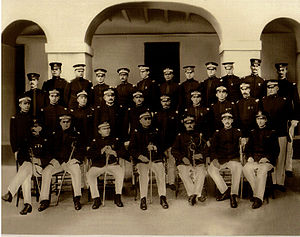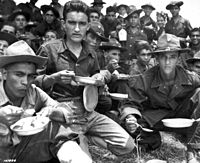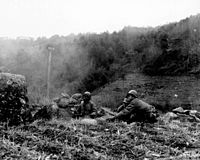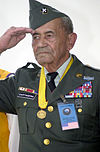- 65th Infantry Regiment (United States)
-
65th Infantry Regiment 
65th Infantry Regiment Coat of Arms

Company C, 65th Infantry Regiment's 2nd platoon "Borinqueneers" pose for pictures in 1952
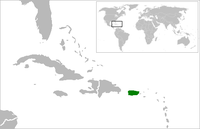
Location of the island of Puerto Rico (green)
Old Coat of Arms, (New coat of arms has national guard crest)Active 4 June 1920–1956/PRANG 1956 to present Country Puerto Rico, United States of America Branch Infantry Branch (United States) Type Infantry regiment Garrison/HQ Puerto Rico Army National Guard Nickname Borinqueneers (Special Designation)[1] Motto Honor and Fidelity Engagements World War I
* Fired first shot of WW I
(on behalf of the U.S.)
World War II
*Naples-Fogis
*Central Europe
* Battle of the Rhineland
Korean War
* Operation "Killer"
* Battle of Cherwon
* "Jackson Heights"
* Outpost KellyCommanders Notable
commandersColonel Antulio Segarra
Colonel William W. Harris
Colonel Juan César Cordero DávilaInsignia Identification
symbolDistinctive Unit Insignia
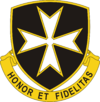
U.S. Infantry Regiments Previous Next 64th Infantry Regiment 66th Infantry Regiment The 65th Infantry Regiment, nicknamed "The Borinqueneers,"[1] was an all-volunteer Puerto Rican regiment of the United States Army. Its motto was Honor et Fidelitas, Latin for Honor and Fidelity. It participated in World War I, World War II, and the Korean War. In 1956, the 65th Infantry was inactivated and became the only unit ever to be transferred from an active Army component to the Puerto Rico National Guard. The 1st Battalion, 65th Infantry Regiment (1–65th Infantry) was assigned to the 92nd Infantry Brigade (now the 92d Infantry Brigade Combat Team), PRARNG along with its sister battalion, the 1–296th Infantry, and has served in the War against Terrorism and Operations Iraqi Freedom/Enduring Freedom.
Puerto Ricans have participated in many American military conflicts, like the American Revolution, when volunteers from Puerto Rico, Cuba, and Mexico fought the British in 1779 under the command of General Bernardo de Gálvez (1746–1786), or the present-day conflict in Iraq and Afghanistan.[2] The 65th Infantry which was originally activated as the "Porto Rico Regiment" in 1898, served in World War I, and fired the first shot of World War I on behalf of the United States. It was involved in active combat during World War II. However, it was during the Korean War that the unit suffered the most casualties. Among the problems that they faced were the difference in languages (the common foot soldier spoke only Spanish, while the commanding officers were mostly English-speaking Americans) and the harsh, cold climate.[3]
Puerto Rico Regiment of Infantry
Puerto Rico became a U.S. Territory after the 1898 Treaty of Paris which ended the Spanish-American War. The United States appointed a military governor and soon the United States Army established itself in San Juan. The Army Appropriation Bill created by an Act of Congress on 2 March 1889 authorized the creation of the first body of native troops in Puerto Rico. On 30 June 1901, the "Porto Rico Provisional Regiment of Infantry" was organized. On 1 July 1901, the United States Senate passed a Bill which would require a strict mental and physical examination for those who wanted to join the Regiment. It also approved the recruitment of native Puerto Rican civilians to be appointed the grade of second lieutenants for a term of four years if they passed the required tests.[3] An Act of Congress, approved on 27 May 1908, reorganized the regiment as part of the "regular" Army. Since the native Puerto Rican officers where Puerto Rican citizens and not citizens of the United States, they were required to undergo a new physical examination to determine their fitness for commissions in the Regular Army and to take an oath of U.S. citizenship with their new officers oath.[4] By 30 January 1917, The Porto Rico Regiment of Infantry was training in Camp Las Casas which was located in Santurce, a section of San Juan in what is now El Residencial Las Casas.
World War I
First shot of World War I fired
Different units of the Regiment were stationed at other forts throughout the island. Lieutenant Teofilo Marxuach was stationed at El Morro Castle at San Juan Bay. Lt. Marxuach was the officer of the day at El Morro Castle on 21 March 1915. The Odenwald, built in 1903 (not to be confused with the German World War II war ship which carried the same name), was an armed German supply ship which tried to force its way out of the San Juan Bay and deliver supplies to the German submarines waiting in the Atlantic Ocean. Lt. Marxuach gave the order to open fire on the ship from the walls of the fort. Sergeant Encarnacion Correa then manned a machine gun and fired warning shots with little effect.[4] Marxuach fired a warning shot from a cannon located at the Santa Rosa battery of "El Morro" fort, in what is considered to be the first shot of World War I fired by the regular armed forces of the United States against any ship flying the colors of the Central Powers,[5] forcing the Odenwald to stop and to return to port where its supplies were confiscated.[6] The shots ordered by Lt. Marxuach were the first fired by the United States in World War I. The Odenwald was confiscated by the United States and renamed SS Newport. It was assigned to the U.S. Shipping Board, where it served until 1924 when it was retired.[7]
On 3 May 1917, the Regiment recruited 1,969 men, considered at that time as war strength, and on 14 May 1917, the Regiment was sent to Panama in defense of the Panama Canal Zone.[8] The Regiment returned to Puerto Rico on March 1919 and was renamed "The 65th Infantry Regiment" by the Reorganization Act of 4 June 1920. During this period a young Puerto Rican officer of the Regular Army, Major Luis R. Esteves, was sent to Camp Las Casas to serve as an instructor in the preparation of Puerto Rican Officers. Esteves in the future would become known as the "Father of the Puerto Rican National Guard".[9]
World War II
In 1942, at the outbreak of World War II, the 65th Infantry underwent an extensive training program and in 1943, it was sent to Panama to protect the Pacific and the Atlantic sides of the isthmus. On 25 November 1943, Colonel Antulio Segarra, proceeded Col. John R. Menclenhall as Commander of the 65th Infantry, thus becoming the first Puerto Rican Regular Army officer to command a Regular Army regiment. On January 1944, the Regiment was embarked for Jackson Barracks in New Orleans and later sent to Fort Eustis in Newport News, Virginia in preparation for overseas deployment to North Africa. After they arrived at Casablanca, they underwent further training. By 29 April 1944, the Regiment had landed in Italy and moved on to Corsica.[10] On 22 September 1944, the 65th Infantry landed in France and was committed to action on the Maritime Alps at Peira Cava. On 13 December 1944, the 65th Infantry, under the command of Lieutenant Colonel Juan César Cordero Dávila, relieved the 2nd Battalion of the 442nd Infantry Regiment, a Regiment which was made up of Japanese Americans under the command of Col. Virgil R. Miller, a native of San German, Puerto Rico. The 3rd Battalion defeated Germany's 34th Infantry Division's 107th Infantry Regiment.[11] They suffered a total of forty seven battle casualties. The first two Puerto Ricans to be killed in action from the 65th Infantry were Pvt. Sergio Sanchez-Sanchez and Sgt. Angel Martinez, from the town of Sabana Grande. On 18 March 1945, the Regiment was sent to the District of Mannheim, Germany and assigned to Military Government activities, anti-sabotage and security missions. In all, the 65th Infantry participated in the battles of Naples-Fogis, Rome-Arno, Central Europe and of the Rhineland. On 27 October 1945 the Regiment sailed from France arriving at Puerto Rico on 9 November 1945.[3][12]
Post World War II
According to the book "Historia Militar De Puerto Rico" (Military history of Puerto Rico), by historian Col. Hector Andres Negroni, the men of the 65th Infantry were awarded the following military decorations[4]:
65th Infantry Regiment
Individual Awards in World War IIAward Name Total Silver Star 2 Bronze Star 22 Purple Heart 90 Operation "PORTREX", prelude to the Korean War
The 65th Infantry Regiment distinguished themselves when the United States conducted a military exercise code named "Operation PORTEX", meaning Puerto Rico Exercise, on the island of Vieques on the eve of the Korean War. The objective was to see how the combined forces of the Army, Marines, Navy and Air Force would do as liberators of an enemy captured territory (Vieques) against the aggressors. The core of the aggressor ground forces were made up of Hispanic soldiers, most of which belonged to the 65th Infantry Regiment.
The liberators consisted of 32,600 combat troops from the 82nd Airborne Division's 504th Airborne Infantry Regiment and Marine Corps, who received support from the Navy and Air Force. Despite the large number of troops deployed, the 65th Infantry (the aggressor) was able to halt the offensive forces on the beaches of the island. Colonel William W. Harris, the commanding officer of the 65th, stated:
"Stopping the assault forces at the water's edge proved that the Puerto Ricans could hold their own against the best-trained soldiers that the United States Army could put into the field"
The successful military maneuvers during PORTREX had prompted the Army's leadership to deploy the 65th Infantry to Korea.[3]
Korean War
 A 1992 painting depicting the Puerto Rican 65th Infantry Regiment's bayonet charge against a Chinese division during the Korean War.
A 1992 painting depicting the Puerto Rican 65th Infantry Regiment's bayonet charge against a Chinese division during the Korean War.
 External audio
External audio
You may watch a newsreel of the "65th Infantry Regiment" in Korea here. On 26 August 1950, the 65th Infantry, with 6,000 officers and men organized into three infantry battalions, one artillery battalion and a tank company departed from Puerto Rico and arrived in Pusan, Korea on 23 September 1950.[13] It was during the long sea voyage that the men nicknamed the 65th Infantry "Borinqueneers". The name is a combination of the words "Borinquen" (which was what the Taínos called the island before the arrival of the Spaniards) and "Buccaneers".
The men of the 65th, now attached to the Army's 3d Infantry Division, were among first infantrymen to meet the enemy on the battlefields of Korea. After November, 1950, they fought daily against units of the Chinese People's Liberation Army after the Chinese entered the war on the North Korean side. One of the hardships suffered by the Puerto Ricans was the lack of warm clothing during the cold and harsh winters. The enemy made many attempts to encircle the Regiment, but each time they failed because of the many casualties inflicted by the 65th. The 65th was part of a task force which enabled the U.S. Marines to withdraw from the Chosin Reservoir on December 1950. When the Marines were encircled by the Chinese Communist troops close to the Manchurian border they were ordered to retreat and they worked their way back to Hungnam. The men of the 65th were rushed to their defense and ordered to stay behind and fight the enemy. As a consequence, the Marines were able to return safely to their ships. The 65th held the rear guard and were the last unit to embark from Hungnam. The men of the 65th who participated in said action were awarded the Navy and Marine Corps Commendation Medal.[14] Among the battles and operations in which the 65th participated was Operation Killer in January 1951, becoming the first Regiment to cross the Han River in South Korea during the operation. On April 1951, the Regiment participated in the Uijonbu Corridor drives and on June 1951, the 65th was the third Regiment to cross the Han Ton River. The 65th was the Regiment which took and held Chorwon and they were also instrumental in breaking the Iron Triangle of Hill 717 on July 1951. On November 1951, the Regiment fought off an attack by two Regimental size enemy units, with success. Colonel Juan César Cordero Dávila was named commander of 65th Infantry on 8 February 1952, thus becoming one of the highest ranking ethnic officers in the Army.[15]
Battles of Outpost Kelly and Jackson Heights
On 3 July 1952, the Regiment defended the main line of resistance (MLR) for 47 days and saw action at Cognac, King and Queen with successful attacks on Chinese positions. On September 1952, the 65th Infantry was holding on to a hill known as "Outpost Kelly". Chinese Communist forces overran the hill in what became known as the Battle for Outpost Kelly. Twice the 65th Regiment was overwhelmed by Chinese artillery and driven off. On October the Regiment also saw action in the Chorwon Sector and on Iron Horse, Hill 391, whose lower part was called "Jackson Heights" in honor of Capt. George Jackson (see: Col. Carlos Betances Ramírez). Company "G" of the 65th fought a desperate battle to hold on to Hill 391, however the Chinese had penetrated their position and had them completely surrounded. They had to fight their way back to the MLR in the dark after they received the order to withdraw, otherwise they would have risked the possibility of being completely wiped out.[3] In June 1953, the 2nd Battalion conducted a series of successful raids on Hill 412 and in November the Regiment successfully counter-attacked enemy units in the Numsong Valley and held their positions until the s:Korean Armistice Agreement was reached.[3]
Mass Court Martial
Col. Cordero Dávila was relieved of his command by Col. Chester B. DeGavre, a West Point graduate and a "continental", an officer from the mainland United States and the officer staff of the 65th was replaced with non-Hispanic officers. DeGavre, upset over the fact that "G" company did not hold on to Hill 391, ordered that the unit stop calling itself the "Borinqueneers", cut their special rations of rice and beans, ordered the men to shave off their mustaches and had one of them wear signs that read "I am a coward".[3] It is believed that humiliation, combat exhaustion and the language barrier where factors that influenced some of the men of Company L in their refusal to continue to fight.[16]
In December 1954, one hundred and sixty-two Puerto Ricans of the 65th Infantry were arrested. Ninety-five soldiers were court martialed and ninety-one were found guilty and sentenced to prison terms ranging from one to 18 years of hard labor. It was the largest mass court-martial of the Korean War. According to cultural historian Silvia Álvarez Curbelo, the government of Puerto Rico, caught in the middle of a potentially damaging affair that could jeopardize its political agenda, kept silent for nearly two months. Finally, the incidents were made known by a local newspaper alerted by several letters written by the imprisoned soldiers to their families. Secret negotiations between the U.S. and Puerto Rican governments, were made and the Secretary of the Army Robert Stevens moved quickly to remit the sentences and granted clemency and pardons to all those involved.[17]
An Army report released in 2001 blamed the breakdown of the 65th on the following factors: a shortage of officers and noncommissioned officers, a rotation policy that removed combat-experienced leaders and soldiers, tactics that led to high casualties, an ammunition shortage, communication problems between largely white, English-speaking officers and Spanish-speaking Puerto Rican enlisted men, and declining morale. The report also found bias in the prosecution of the Puerto Ricans, citing instances of continental soldiers who were not charged after refusing to fight in similar circumstances, before and after Jackson Heights.[16] Though the men who were court martialed were pardoned, there currently is a campaign for a formal exoneration.[18]
Post Korean War
A total of 61,000 Puerto Ricans served in the military during the Korean War, most of them volunteers.[19] The 65th Infantry was awarded battle participation credits for the following nine campaigns: UN Defense-1950, UN Offense-1950, CCF Intervenntion-1950, First UN Counterattack Offensive-1951, UN and CCF Spring Offensive-1951, UN Summer-Fall Offensive-1951, 2nd Korean Winter 1951–52, Korean Summer-Fall-1952 and 3rd Korean Winter-1952-53. They are credited with the last battalion-sized bayonet assault in U.S. Army history.[20]
65th Infantry Regiment
Individual Awards in the Korean WarAward Name Total Distinguished Service Cross 10 Silver Star 256 Bronze Star 606 Ten Distinguished Service Crosses, 256 Silver Stars and 606 Bronze Stars for valor were awarded to the men of the 65th Infantry. Of the ten Distinguished Service Crosses that were awarded to the members of the 65th Infantry, 5 were awarded to Puerto Ricans.
Table: Puerto Ricans who were awarded the Distinguished Service Cross Name Highest rank reached Modesto Cartagena Sergeant First Class Badel Hernandez Guzman Private Juan E. Negron Master Sergeant Fabian Nieves Laguer Corporal Belisario Noriega Master Sergeant According to El Nuevo Día newspaper, 30 May 2004 a total of 756 Puerto Ricans lost their lives in Korea, from all four branches of the U.S. Armed Forces.[3] However, according to "All POW-MIA Korean War Casualties", the total amount of Puerto Rican casualties in the Korean War was 732, meaning that one in every forty-two casualties in the war was a Puerto Rican, however this total may vary slightly since some non-Puerto Ricans such as Captain James W. Conner were mistakenly included. Out of the 700 plus casualties suffered in the war a total of 121 men were listed as Missing in Action.[21] The Battle of Outpost Kelly accounted for 73 of the men missing in action from the total of 121.[22] Out of the 73 MIA's suffered by the regiment in the month of September 1952, 50 of them occurred on the same day, 18 September. For a list of names of those who were declared MIA, see: List of Puerto Ricans Missing in Action in the Korean War.[23] On 12 February 1951, General Douglas MacArthur, was quoted in Tokyo saying the following:[24]
"The Puerto Ricans forming the ranks of the gallant 65th Infantry on the battlefields of Korea…are writing a brilliant record of achievement in battle and I am proud indeed to have them in this command. I wish that we might have many more like them."
The 65th Infantry was relieved from assignment to the 3d Infantry Division on 3 November 1954 and, returning to Puerto Rico, it was assigned on 2 December 1954 to the 23d Infantry Division, which encompassed geographically-separated units in the Caribbean region. On 10 April 1956 it was inactivated at Camp Losey, Puerto Rico, and relieved from assignment to the 23d, which itself was inactivated.
On 6 February 1959 the regiment was withdrawn from the Regular Army and allotted to the Puerto Rican Army National Guard as a parent regiment under the Combat Arms Regimental System (CARS) after Brig. General Juan Cordero, Puerto Rico's Adjutant General, persuaded the Department of the Army to transfer the 65th Infantry from the Regular Army to the Puerto Rico National Guard. This was the only unit ever transferred from active component Army to the National Guard. This was accomplished by reflagging the PR ARNG's existing 296th Regimental Combat Team at Camp Losey.
On 15 February 1959 it was organized to consist of the 1st Battle Group, 65th Infantry, an element of the 92d Infantry Brigade. On 1 May 1964 it was reorganized to consist of the 1st Battalion, 65th Infantry, and remained assigned to the 92d. It was reorganized again on 1 April 1971 to consist of the 1st Battalion and the separate Company E. This was followed by another reorganization on 1 September 1978 to consist of the 1st and 2d Battalions within the 92d, as well as the separate Company E. Less than two years later another reorganization on 29 February 1980 eliminated the separate Company E while retaining the 1st and 2d Battalions.
On 27 October 1987 the regiment was withdrawn from CARS and reorganized under the United States Army Regimental System with Headquarters at Cayey. It was reorganized on 1 September 1992 to consist of the 1st Battalion, 65th Infantry, and remained assigned to the 92d Infantry Brigade.
On 14 February 2003 it was ordered into active federal service at home stations and released on 12 February 2005, reverting to territorial control. On 1 October of that year it was reorganized as the 65th Infantry Regiment in which only the 1st Battalion was active.
The separate Company E was a Ranger unit given federal recognition effective 1 April 1971 and had a total authorized strength of 198 personnel. It was added to the PR ARNG on that date while the 755th Transportation Company (Medium Truck, Cargo) was deleted. Co E (Ranger), 65th Infantry relocated from Vega Baja to San Juan on 2 February 1976, and was inactivated as federal recognition was withdrawn effective 29 February 1980. This resulted in the allocation of an ARNG ranger company being transferred from the PR ARNG to the Texas ARNG, in which Company G (Ranger), 143d Infantry was activated in Houston from elements of the 2d Battalion (Airborne), 143d Infantry, 36th Airborne Brigade, which was being inactivated effective 1 April 1980.
Twenty-first century
The 65th Infantry Regiment's 1st Battalion, along with its sister battalion, the 1–296th Infantry, was transferred to the 92d Infantry Brigade, PRARNG (now the 92nd Infantry Brigade Combat Team). Both battalions have served in what the United States and its allies call the War against Terrorism and Operation Iraqi Freedom/Enduring Freedom.[24]
In 2009, Company C, 1st Battalion, 65th Infantry Regiment was deployed to the Horn of Africa and stationed at Camp Lemonnier in Djibouti, after completing 14 months of deployment in Guantanamo Bay, Cuba. Company C carried the crew-served weapons to protect the camp. It also operated the entry control checkpoints, protected U.S. and allied ships at the massive Djibouti Port, and guarded the U.S. Embassy there. By mid-2009, the rest of the battalion deployed there in case a larger combat maneuver element was needed to operate from the base. The area is considered as the most unstable part of Africa, and the Somalian border is less than 10 miles from Camp Lemonnier.[25]
Legacy
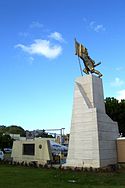 Monument to the 65th Infantry Regiment at the start of the avenue of the same name, in San Juan, Puerto Rico
Monument to the 65th Infantry Regiment at the start of the avenue of the same name, in San Juan, Puerto Rico
Puerto Rico honored the unit by naming one of its principal avenues "La 65 de Infanteria" in San Juan. The names of those who perished in combat are inscribed in "El Monumento de la Recordación" (Monument of Remembrance), which was unveiled on 19 May 1996 and is situated in front of the Capitol Building in San Juan, Puerto Rico.
In November 1999, Governor Pedro Rossello, along with the Senate of Puerto Rico, chartered the 65th Infantry Honor Task Force and appointed Anthony Mele, Chairman to work with Major General Nels Running, Director, Committee of the 50th Anniversary of the Korean War to commemorate the gallantry of the 65th Infantry Regiment of Puerto Rico. Tree planting and plaque commemoration ceremonies were organized around the USA, to include Arlington National Cemetery in Virginia; Fort San Felipe del Morro in San Juan, Puerto Rico; and Fort Logan National Cemetery in Denver. The 65th Infantry Honor Task Force continues to honor the veterans of the 65th Infantry Regiment, wherever and whenever they are found.[26]
On 20 May 2001, the government of Puerto Rico unveiled a monument honoring the 65th Infantry Regiment. The monument contains a statue of a soldier wearing a poncho with his rifle in one hand and the regiment's flag in the other hand.[27]
On 7 June 2007, PBS aired The Borinqueneers, a documentary about the 65th Infantry written and directed by Noemí Figueroa Soulet with Raquel Ortiz as co-director. The narrators were Hector Elizondo (English) and David Ortiz-Anglero (Spanish).[28]
Puerto Rican members of the 65th Infantry
Among the notable Puerto Ricans from the regiment who distinguished themselves are:
Table: Notable Puerto Ricans who served in the 65th Infantry Regiment Highest rank reached Name Notability Major General 
Juan César Cordero DávilaCommanding officer of the 65th Infantry Regiment during the Korean War Brigadier General 
Antonio Rodríguez BalinasFirst commander of the Office of the First U.S. Army Deputy Command (awarded two Silver Stars) Colonel 
Virgil R. MillerThe 442nd Regimental Combat Team Commander who led the rescue of the "Lost Battalion" during World War II Colonel
Carlos Betances RamirezOnly Puerto Rican officer to command an infantry battalion in the Korean War Colonel 
Antulio SegarraFirst Puerto Rican Regular Army officer to command a Regular Army regiment Lieutenant Colonel 
Teófilo MarxuachFired the first shot in what is considered to be the first shot of World War I fired by the regular armed forces of the United States against any ship flying the colors of the Central Powers[5] Master Sergeant 
Pedro RodriguezAwarded two Silver Stars in one week Sergeant First Class 
Agustín Ramos CaleroAmong the most decorated (22 decorations) soldiers in the United States during World War II Sergeant First Class 
Modesto CartagenaThe most decorated Puerto Rican soldier in history Unit citations
The 65th Infantry was awarded the following citations:
 Navy and Marine Corps Commendation Medal
Navy and Marine Corps Commendation Medal National Defense Service Medal
National Defense Service Medal World War I Victory Medal
World War I Victory Medal American Defense Service Medal
American Defense Service Medal American Campaign Medal
American Campaign Medal European-African-Middle Eastern Campaign Medal
European-African-Middle Eastern Campaign Medal World War II Victory Medal
World War II Victory Medal Army of Occupation Medal
Army of Occupation Medal Presidential Unit Citation (twice)
Presidential Unit Citation (twice) Meritorious Unit Commendation (twice)
Meritorious Unit Commendation (twice) Republic of Korea Presidential Unit Citation (twice)
Republic of Korea Presidential Unit Citation (twice)
Foreign decoration
- Chryssoun Aristion Andrias (Bravery Gold Medal of Greece)
Further reading
- "Historia militar de Puerto Rico"; by: Hector Andres Negroni; publisher: Sociedad Estatal Quinto Centenario (1992); isbn=8478441387
- "Honor and Fidelity: The 65th Infantry in Korea, 1950–1953"; By: Gilberto N. Villahermosa, Center of Military History, and Jeffrey J. Clarke; Publisher: www.MilitaryBookshop.co.uk; ISBN 1780390513; ISBN 978-1780390512
See also
- Camp Las Casas
- List of Puerto Ricans Missing in Action in the Korean War
- List of Puerto Rican military personnel
Other military articles related to Puerto Rico:
- Military history of Puerto Rico
- El Grito de Lares
- Intentona de Yauco
- Puerto Rican Campaign
- Puerto Ricans in World War I
- Puerto Ricans in World War II
- Puerto Ricans in the Vietnam War
- Puerto Rican women in the military
- Puerto Rico National Guard
References
- ^ a b "Special Designation Listing". United States Army Center of Military History. 21 April 2010. http://www.history.army.mil/html/forcestruc/spdes-123-arng.html. Retrieved 14 July 2010.
- ^ Maryland State Resolution on the role played by Hispanics in the achievement of American independence, Retrieved on 4 August 2007.
- ^ a b c d e f g h Villahermosa, Gilberto N. (2009). Honor and Fidelity: The 65th Infantry in Korea, 1950–1953. Government Printing Office. ISBN 9780160833243.
- ^ a b c "Historia Militar de Puerto Rico"; by Héctor Andrés Negroni; pg. 370; ISBN 84-7888-138-7
- ^ a b "US Naval Institute Proceedings"; "A Breach of Neutrality"; by: Lt. Isaiah Olch, US Navy; Vol. 62; July – December 1936
- ^ "CALLS ODENWALD AFFAIR AN ATTACK; Fired On Without Warning Shot, Germany Asserts, Contradicting San Juan Commander. SAYS SHE WAS UNDULY HELD Violated Clearance to Elude Enemy Cruisers That Had Been Warned She Was About to Sail.". New York Times. 7 April 1915. http://query.nytimes.com/gst/abstract.html?res=9B00EFDA1E3EE033A25754C0A9629C946496D6CF. Retrieved 10 August 2008.
- ^ Newport News
- ^ Puerto Rico National Guard, Retrieved 8 September 2007
- ^ Richard A. Stewart, ed (2005). "2. Between World Wars". American Military History Volume II. Army Historical Series. Washington, D.C.. CMH Pub 30-22. http://www.history.army.mil/books/AMH-V2/AMH%20V2/chapter2.htm. Retrieved 8 September 2007.
- ^ "Military History". American Veteran's Committee for Puerto Rico Self-Determination. http://veteransforpr.com/history.htm. Retrieved 27 June 2007.
- ^ LTC Gilberto Villahermosa (September 2000). "World War II". "Honor and Fidelity" – The 65th Infantry Regiment in Korea 1950–1954 (Official Army Report on the 65th Infantry Regiment). United States Army Center of Military History. http://www.history.army.mil/html/books/korea/65Inf_Korea/index.html. Retrieved 27 June 2007.
- ^ W.W. Harris (2001). Puerto Rico's Fighting 65th U.S. Infantry:From San Juan to Chowon. Presidio Press. ISBN 0-89141-056-2.
- ^ Fact Sheet, Retrieved 13 September 2007
- ^ Puerto Rico Herald, The Hartford Courant; New Generation Fights For 65th; By MATTHEW HAY BROWN
- ^ "Outpost Kelly". http://mervino.com/window/IBB/map65th.html. Retrieved 10 October 2006.
- ^ a b From Glory to Disaster and Back, Retrieved 8 September 2007
- ^ ReVista, "War, Modernity and Remembrance", by: Silvia Alvarez Curbelo
- ^ http://www.puertorico-herald.org/issues/2002/vol6n22/NewGenFights65th-en.shtml
- ^ Military History, Retrieved 15 September 2007
- ^ 110th Congress, 18th Session, H. Con. Res. 253
- ^ "All POW-MIA Korean War Casualties: Puerto Rico". Advocacy & Intelligence Index For POWs-MIAs Archives. Archived from the original on 9 June 2007. http://web.archive.org/web/20070609215932/http://www.aiipowmia.com/koreacw/kwkia_puertorico.html. Retrieved 7 September 2007.
- ^ Jack R. Siewert (2002). Outpost Kelly: A Tanker's Story. Fire Ant Books. ISBN 9780817353414.
- ^ "The 65th Infantry Regiment on Kelly in September 1952". Mervino.com. http://mervino.com/window/IBB/map65th.html. Retrieved 7 September 2007.
- ^ a b The 65th Infantry Regiment "Honor and Fidelity", Retrieved 8 September 2007
- ^ Puerto Rico's 1/65th Army Borinqueneers Takes Over Security in Horn of Africa
- ^ (www.borinqueneers.net)
- ^ Puerto Rican Soldier, Retrieved 8 September 2007
- ^ PBS
Further reading
- Villahermosa, Gilberto N. (2009). Honor and Fidelity:The 65th Infantry in Korea, 1950–1953. Washington, D.C.: United States Army Center of Military History. CMH Pub 70-116-1. http://www.history.army.mil/html/books/korea/65Inf_Korea/index.html.
External links
- Suggested Reading on the 65th Infantry compiled by the United States Army Center of Military History
- Hispanic Americans in the U.S. Army
- The Borinqueneers Website – website honoring the 65th Infantry Regiment, this site contains the casualty lists, medal lists, regimental history, recent historical articles, regimental roster for the Korean War, Korean War News, photos, current events, and archival film.
Categories:- Military history of Puerto Rico
- Infantry regiments of the United States Army
- United States Army units and formations in the Korean War
- Military units and formations in Puerto Rico
Wikimedia Foundation. 2010.

